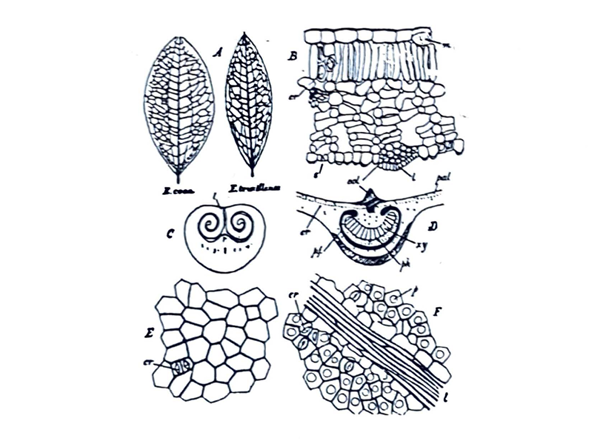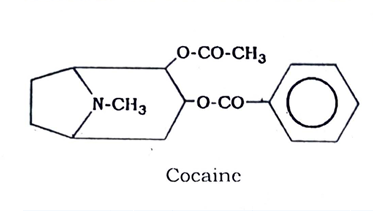Synonyms: Coca Leaves, Folia Cocae
Botanical source: Coca consists of the dried leaves of Erythroxylum coca Lam. (Bolivian or Huanuco coca) and E. truxillense Rusby (Peruvian or Truxillo coca) of the family Erythroxylaceae. Coca plants are small shrubs.
Geographical Source ofCoca Plant: Coca plants are cultivated in Peru, Bolivia, Java and Formosa. No wild variety is known.

Fig. 29: Coca. A, leaves of Erythroxylum coca and E. truxillense; B, t.s. of a leaf; C, t.s. of a leaf from bud; D, t.s. (diagrammatic) of a leaf midrib; E. & F, upper ad lower epidermises of a leaf: col, collenchyma; er, prism of calcium oxalate; 1, lateral line; m, mucilage; p, papilla; pal, palisade, p.f, pericyclic fibres; ph, phloem; s, stoma; xy, xylem. (Reproduced from Wallis).
Macroscopical Characters of Coca Plants
Coca leaves are simple, very short-petioled, 3.5 to 8 cm long and 2 to 4 cm broad, oval to ovate-lanceolate in shape with an entire margin and acute apex. Surface glabrous with two distinct (Bolivian coca) or indistinct (Peruvian coca) ridges, one each side of the midrib on lower surface. They may be brownish green (Bolivian) or yellowish green (Peruvian) (Peruvian) in colour, firm (Bolivian) or brittle (Peruvian) in texture and possess slight odour. Taste at first bitter followed by a numbing sensation.
Microscopical Characters Coca Plants
The epidermal cells are polygonal with straight anticlinal wall. Outer walls of the lower epidermal cells are papillose. Paracytic (rubiaceous) stomata are present on the lower surface only. A few epidermal cells contains mucilage, and Prisms and clusters of calcium oxalate occur in a few cells of both epidermises. Prisms and clusters oxalate are also present in the mesophyll cells. The ridges of the leaf are filled with collenchymatous cells and the midrib possesses and area of xylem and a band of phloem with a band of pericyclic fibres below and also some sclerenchymatous cells above.
Chemical constituents Coca
Coca leaves contain 0.5 to 1.5 percent alkaloids of the tropane group, most important of which is cocaine. Other tropane alkaloids present in N-CH3 0-CO it include cinnamylcocaine, truxilline, benzoylecgonine and ecgonine. Peruvian and Java coca leaves are richer in total alkaloid content. ln addition to the tropane alkaloids, thee contain cocatannic acid.

Uses of Coca Plants
Coca is a stimulant tonic and a restorative drug. it is used during convalescence. Cocaine hydrochloride is used as a local anaesthetic. in minor surgical operations. Cocaine is an addicting alkaloid and is drug of abuse. This alkaloid is thus rampantly used throughout the world for illicit purposes. Its general use as a drug is thus legally prohibited.

